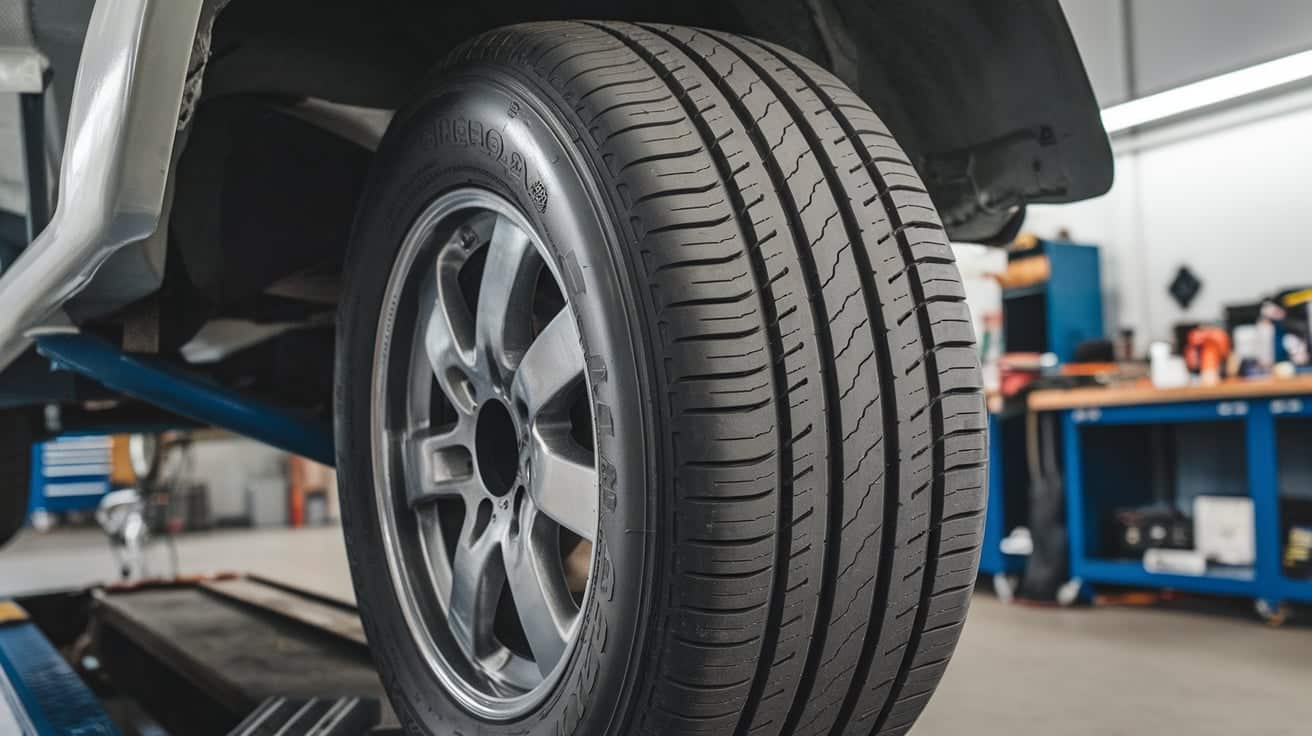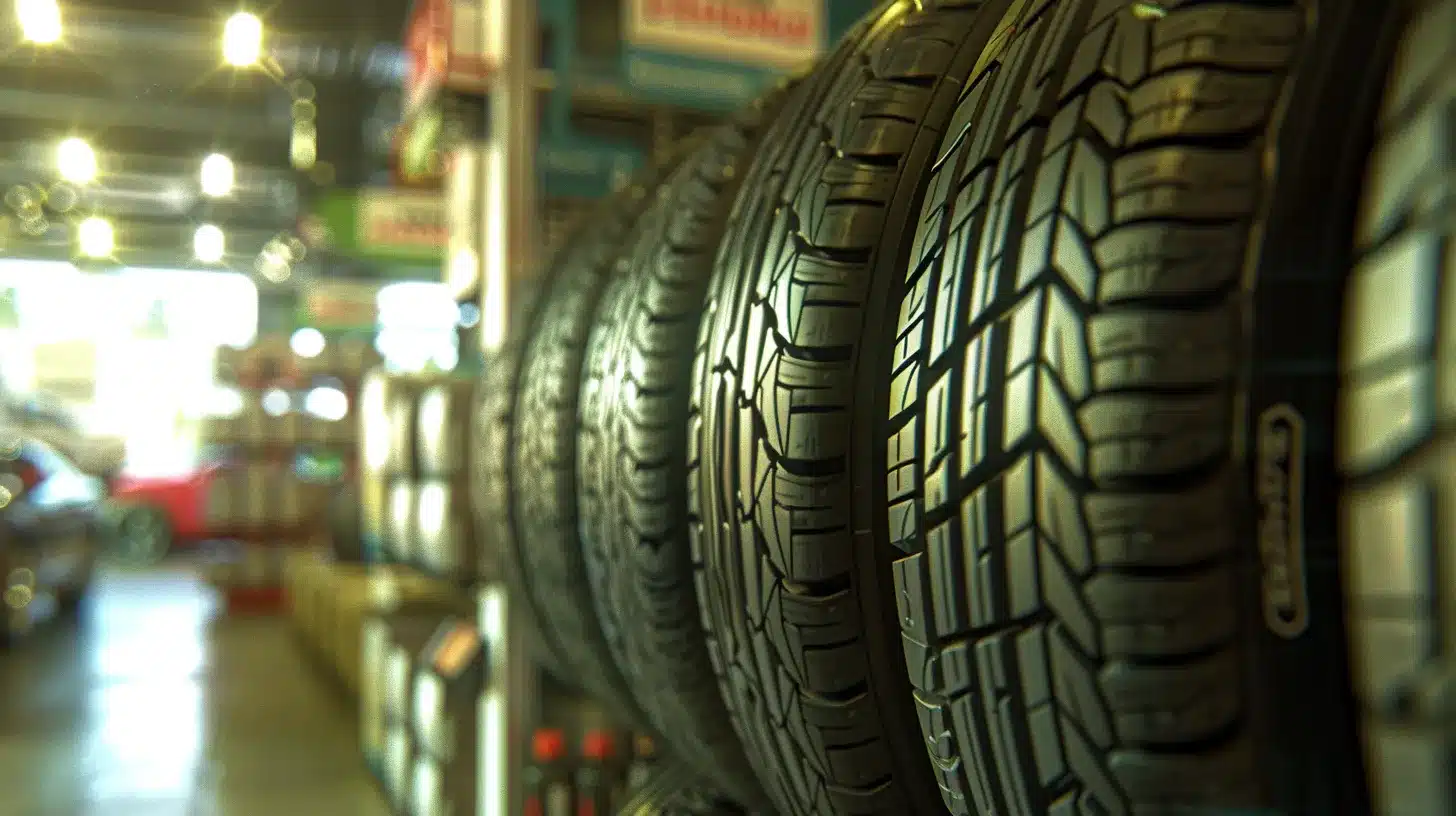Have you ever found yourself faced with a wide array of tires and felt uncertain about which to choose? You’re not alone.
Tire shopping can be daunting, with numerous options and technical terms to decipher.
But here’s a helpful tip: understanding one key aspect – the ply rating – can greatly simplify your decision.
In this guide, we’re exploring 4-ply tires. These often-overlooked components offer a good balance of comfort, affordability, and performance that could be ideal for your vehicle.
Whether you use your car for daily trips, weekend outings, or a mix of both, this guide will help you understand the essentials of 4-ply tires.
Join us as we examine why these tires might suit your needs and how to select the best set for your vehicle.
Get ready to learn about a tire option that could enhance your driving experience.
4-Ply Tires: What They Are and Why They Matter

4-ply tires are a popular choice for many vehicle owners, offering a balance between durability and comfort.
Let’s delve into what these tires are, why you might choose them, and their key benefits.
1. Decoding the 4-Ply Tire
4-ply tires are named for their construction, which involves multiple layers of material.
These layers contribute to the tire’s overall strength and performance characteristics.
Basic Construction
4-ply tires get their name from the number of fabric layers, or plies, that make up the tire’s structure.
These layers, typically made from materials like polyester, give the tire its strength and flexibility.
While modern tire technology has evolved, and tires might not always have exactly four layers, the term “4-ply” is still used to indicate a tire’s relative strength and load-carrying capacity.
Balance of Flexibility and Strength
4-ply tires offer a balanced mix of flexibility and strength, making them suitable for various driving conditions.
This balance allows for a smoother ride on city streets while providing enough durability for light off-road use and general driving needs.
The flexibility helps absorb road imperfections, while the strength ensures the tire can handle daily wear and tear.
2. Why Choose 4-Ply Tires?
Selecting the right tire for your vehicle depends on various factors, including your driving habits and the type of vehicle you own.
4-ply tires offer several advantages that make them a popular choice for many drivers.
Typical Scenarios for 4-Ply Tires
4-ply tires are ideal for drivers who mostly drive in urban environments but occasionally venture onto light off-road terrain.
They’re designed to handle the demands of city driving, such as frequent stops and starts, while also being tough enough for the occasional drive on gravel or dirt roads.
This versatility makes them a great all-around choice for many drivers.
Vehicle Types Best Suited for 4-Ply Tires
Sedans, light SUVs, and smaller trucks commonly use 4-ply tires.
These vehicles benefit from the balance of comfort and durability that 4-ply tires offer, especially for drivers needing reliable tires for a mix of city and light off-road driving.
The tires provide enough strength for these vehicle types without compromising on ride quality.
Key Benefits of 4-Ply Tires

4-ply tires offer several advantages that make them a popular choice among vehicle owners.
Let’s explore some of these key benefits.
1. Smoother Ride and Improved Fuel Efficiency
One of the main advantages of 4-ply tires is their ability to provide a smooth, comfortable ride while also contributing to better fuel efficiency.
The flexibility of 4-ply tires helps absorb road imperfections more effectively than higher-ply tires, resulting in less road noise and a more comfortable driving experience.
Additionally, the lower rolling resistance of 4-ply tires can help improve fuel efficiency, saving you money at the pump over time.
2. Cost-Effectiveness
4-ply tires are generally more affordable than higher-ply options, making them a cost-effective choice for many drivers.
The initial lower cost combined with decent durability makes 4-ply tires an attractive option for budget-conscious consumers.
This cost-effectiveness doesn’t mean a significant compromise on quality, as 4-ply tires still offer good performance for their intended use.
Assessing Your Needs for 4-Ply Tires
Choosing the right tires for your vehicle is crucial for safety, performance, and comfort.
When considering 4-ply tires, it’s important to assess your specific needs and driving conditions.
Let’s explore the key factors to consider when determining if 4-ply tires are the right choice for you.
1. Evaluate Your Driving Conditions

Your typical driving environment plays a significant role in determining whether 4-ply tires are suitable for your needs.
Urban vs. Rural Driving
4-ply tires are generally better suited for urban driving, where roads are typically smoother and more predictable.
In city settings, these tires offer a comfortable ride, good handling, and efficient fuel consumption.
The flexibility of 4-ply tires helps absorb minor road imperfections common in urban areas, resulting in a smoother driving experience.
For rural driving, where roads might be rougher or less maintained, 4-ply tires can still perform well but may wear out faster compared to higher-ply options.
If you frequently drive on unpaved or poorly maintained roads, you might want to consider tires with a higher ply rating for increased durability.
Seasonal Considerations
The performance of 4-ply tires varies across different weather conditions. In moderate climates with occasional rain, 4-ply tires typically perform adequately.
However, for colder climates where snow or ice is common, it’s essential to consider winter-specific tires if the 4-ply option lacks the necessary traction.
In hot climates, 4-ply tires can provide a smoother ride due to their flexibility.
The softer compound used in these tires can adapt better to heat expansion, potentially offering better grip on hot road surfaces.
2. Consider Your Vehicle Type

The type of vehicle you drive significantly influences whether 4-ply tires are the right choice.
Impact of Vehicle Weight, Size, and Purpose
Smaller vehicles like sedans and light SUVs benefit most from 4-ply tires due to their lighter weight and typical usage.
These vehicles don’t require the extra strength of higher-ply tires for their day-to-day operations, and the comfort and fuel efficiency benefits of 4-ply tires are more pronounced.
Larger vehicles, such as heavy-duty trucks, may require higher-ply tires to handle their weight and load capacity.
The increased strength of higher-ply tires is often necessary for these vehicles to operate safely and efficiently.
Manufacturer Recommendations
Adhering to your vehicle’s manufacturer recommendations is crucial for optimal performance and safety.
Always consult your vehicle’s owner manual or contact the manufacturer to ensure that 4-ply tires meet your vehicle’s load and speed requirements.
Using tires with the wrong ply rating can affect vehicle handling, tire wear, and overall safety.
3. Load and Usage Requirements

Understanding your vehicle’s load capacity and typical usage is essential when selecting 4-ply tires.
Understanding Load Capacity
4-ply tires are designed for lighter loads, making them ideal for regular commuting and light cargo transport.
It’s crucial to know your vehicle’s load capacity and ensure that the 4-ply tires you’re considering can handle this weight.
Exceeding the load capacity can lead to tire failure and reduced performance.
Towing and Heavy Loads
For vehicles that occasionally tow or carry heavy loads, 4-ply tires may not be the best choice.
If you frequently tow trailers or carry heavy cargo, consider tires with a higher ply rating for added strength and durability.
The extra reinforcement in higher-ply tires provides better stability and safety when handling heavier loads.
4. Tread Patterns and Their Impact

The tread pattern on a 4-ply tire significantly affects its performance in different driving conditions.
Tread Patterns in 4-Ply Tires
Common tread patterns found in 4-ply tires include symmetrical, asymmetrical, and directional patterns.
Each pattern impacts traction, handling, and noise levels differently:
- Symmetrical patterns offer a quiet ride and even wear, ideal for everyday driving.
- Asymmetrical patterns provide a balance of performance in both wet and dry conditions.
- Directional patterns excel in wet conditions due to their water-channeling capabilities.
Suitability for Various Conditions
Selecting the right tread pattern can enhance the performance of 4-ply tires based on your specific driving conditions.
For instance, if you frequently drive in rainy conditions, a directional tread pattern might be more suitable due to its superior water dispersion properties.
For a mix of city and highway driving, an asymmetrical tread could offer the best all-around performance.
When assessing your needs for 4-ply tires, it’s crucial to consider your typical driving conditions, vehicle type, and load requirements.
By understanding these factors, you can make a more informed decision about whether 4-ply tires are the right choice for you.
Remember, the goal is to find tires that offer the best balance of performance, comfort, and safety for your specific situation.
If you’re unsure about which tire option is best for your needs, don’t hesitate to consult with a tire professional.
They can provide expert advice based on your unique circumstances and help ensure you select the most appropriate tires for your vehicle and driving style.
Making the Right Choice: How to Select the Perfect 4-Ply Tires

Choosing the right 4-ply tires for your vehicle can seem like a daunting task, but with the right approach, you can make an informed decision that enhances your driving experience.
Follow this step-by-step guide to ensure you select the perfect 4-ply tires for your needs.
Step 1: Check Your Vehicle’s Specifications
Begin by confirming whether 4-ply tires are compatible with your vehicle.
This crucial first step ensures that you’re considering the right options from the start.
To find this information, consult your vehicle’s owner manual. Look for details about load capacity, speed rating, and tire size.
These specifications are critical for maintaining safety, optimal handling, and tire longevity.
Using tires that don’t meet your vehicle’s requirements can lead to poor performance and potentially dangerous driving conditions.
Remember, while 4-ply tires might be suitable for many vehicles, some may require higher ply ratings depending on their weight and intended use.
Step 2: Assess Your Driving Habits and Typical Road Conditions
Once you’ve confirmed that 4-ply tires are appropriate for your vehicle, it’s time to match your driving habits with the right tire choice.
Consider your typical driving patterns:
- City driving: If you primarily navigate urban environments, 4-ply tires can offer a good balance of comfort and fuel efficiency. The flexibility of these tires helps absorb road imperfections common in city settings.
- Highway commuting: For those who spend a lot of time on highways, look for 4-ply tires that offer good stability at higher speeds and low rolling resistance for better fuel economy.
- Light off-roading: While 4-ply tires aren’t ideal for serious off-road use, some models can handle occasional gravel or dirt roads. If this describes your driving, look for 4-ply tires with more aggressive tread patterns.
Your local climate also plays a role. If you experience frequent rain, snow, or extreme temperatures, look for 4-ply tires designed to handle these conditions.
Step 3: Compare Tread Patterns and Sidewall Features
The tread pattern of your 4-ply tires significantly influences their performance in different conditions. Here are the main types to consider:
- Symmetrical: These offer a quiet ride and even wear, making them ideal for everyday driving and highway use.
- Asymmetrical: Versatile for both wet and dry conditions, these tires often provide a good balance for varied driving conditions.
- Directional: Best suited for areas with frequent rain, these tires excel at channeling water away from the tire’s surface.
Also, pay attention to sidewall design. Some 4-ply tires feature reinforced sidewalls for added durability, which can be beneficial if you occasionally encounter rougher roads.
Step 4: Review Durability and Treadwear Ratings
Ensuring your chosen tires will last is crucial for both safety and value for money.
While 4-ply tires may not be as rugged as higher-ply options, many still offer good longevity with proper maintenance.
Check the treadwear rating of the tires you’re considering.
This number gives you an estimate of how long the tire should last compared to a standard reference tire.
A higher number indicates a longer-lasting tire. Also, look for additional durability features.
Some 4-ply tires incorporate special rubber compounds or construction techniques to enhance their lifespan.
Advantages and Drawbacks of 4-Ply Tires
When considering 4-ply tires for your vehicle, it’s essential to weigh their benefits against potential limitations.
This balanced perspective will help you make an informed decision based on your specific needs.
Advantages of 4-Ply Tires
1. Ride Comfort
4-ply tires excel in providing a smooth and comfortable ride, particularly on paved roads and in urban environments.
Their flexibility allows for better absorption of road imperfections, resulting in reduced road noise and vibrations.
This makes them an excellent choice for daily commutes and extended highway drives.
2. Cost-Effectiveness
One of the most appealing aspects of 4-ply tires is their affordability.
Generally less expensive than higher-ply options, they offer good value for money, especially for drivers who don’t require heavy-duty tires.
This cost-effectiveness makes them an attractive option for budget-conscious consumers who still want reliable performance for everyday driving.
3. Versatility
4-ply tires demonstrate impressive versatility, suitable for a range of vehicles and driving conditions.
Their design strikes a balance between comfort and durability, making them appropriate for sedans, light SUVs, and small trucks.
This adaptability extends to various driving scenarios, including light off-road use, enhancing their appeal for drivers with diverse needs.
Potential Drawbacks of 4-Ply Tires
1. Lower Load Capacity
The primary limitation of 4-ply tires is their lower load-carrying capacity compared to higher-ply options.
This makes them less suitable for vehicles that frequently carry heavy loads or for drivers who regularly tow trailers.
Exceeding the recommended load capacity can lead to tire strain and potential failure, compromising safety and performance.
2. Reduced Durability Under Heavy Use
While 4-ply tires perform well under normal driving conditions, they may wear out faster when subjected to demanding environments or heavy use.
Their thinner construction, which contributes to their comfort, may not withstand the same level of stress as higher-ply tires when used in rough terrains or on vehicles requiring high durability.
Final Thoughts
You’re now equipped with vital knowledge about 4-ply tires, understanding their structure, benefits, and limitations.
This information is your roadmap to making a smart choice for your vehicle.
Consider how 4-ply tires might enhance your daily drives and weekend trips, offering a balance of comfort, affordability, and performance.
Remember, they’re not just about the number of layers – they’re about finding the right fit for your specific needs.
As you shop for new tires, put this knowledge to use. Speak with tire experts, compare options, and find the perfect match for your vehicle.
The tires you choose play a crucial role in your driving experience, connecting you to every mile of your journey.
Make an informed decision, and enjoy the smooth, worry-free rides ahead. Safe travels!


